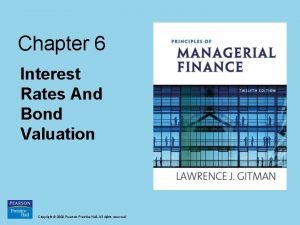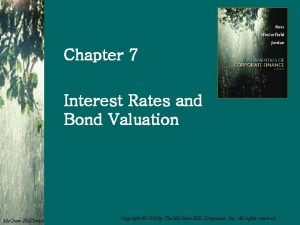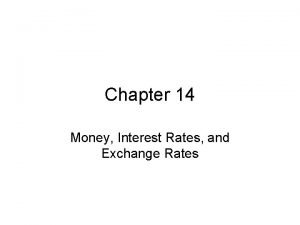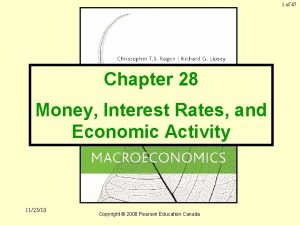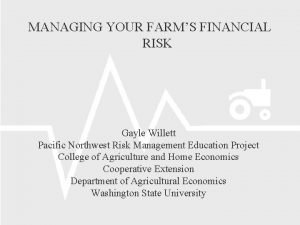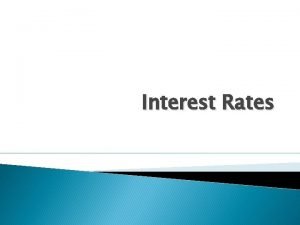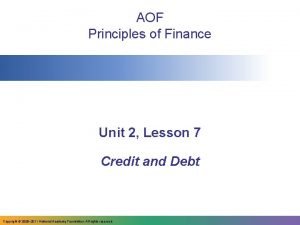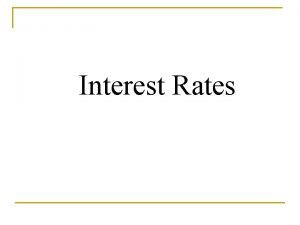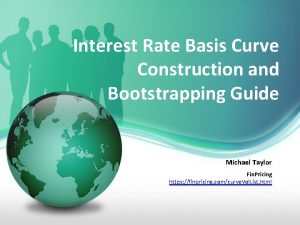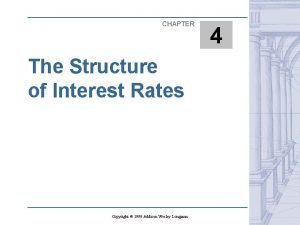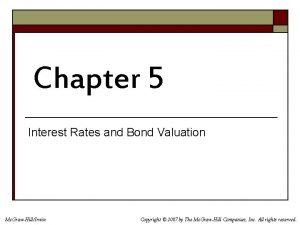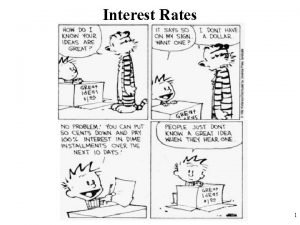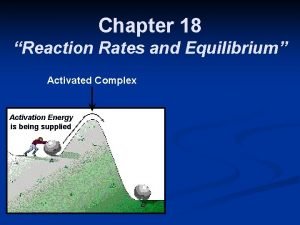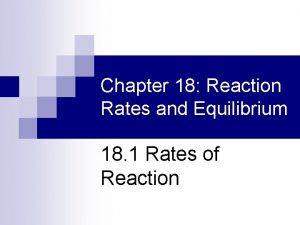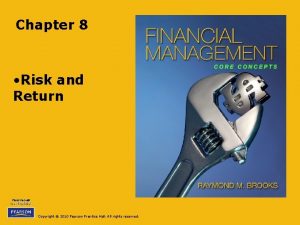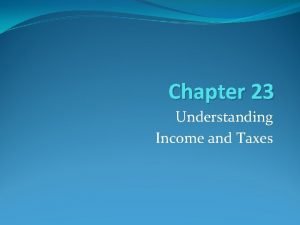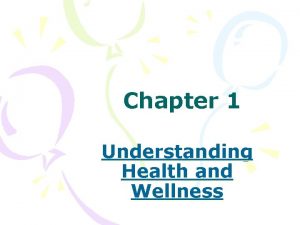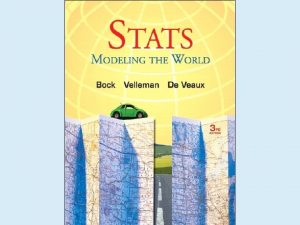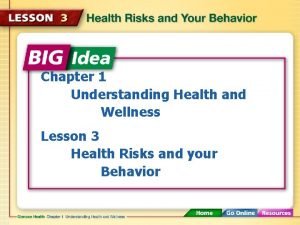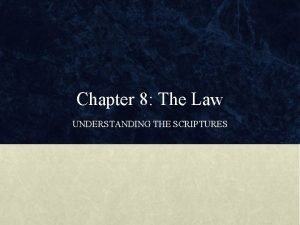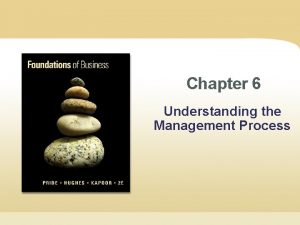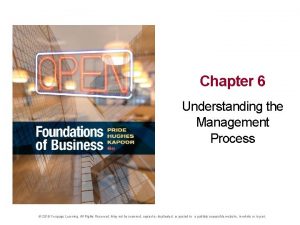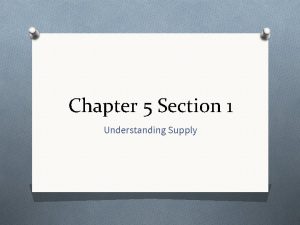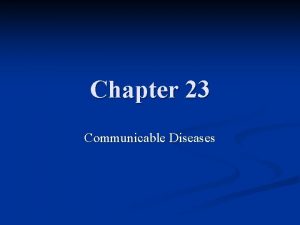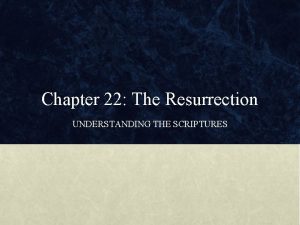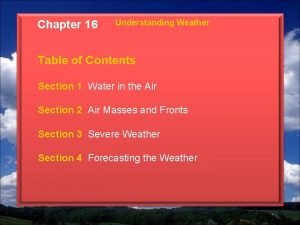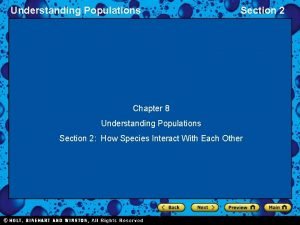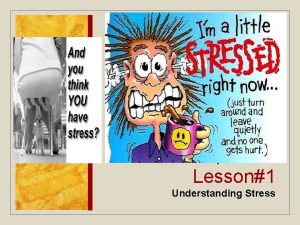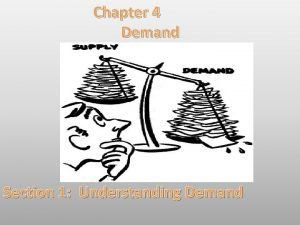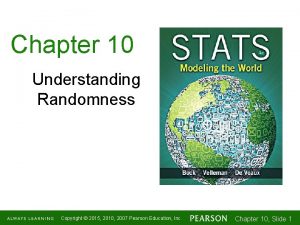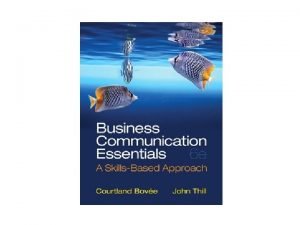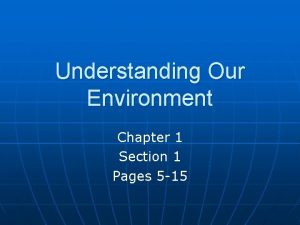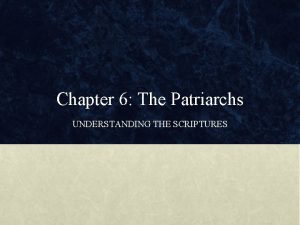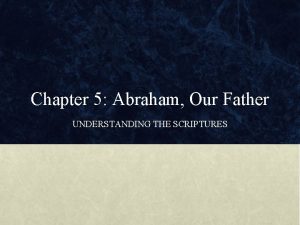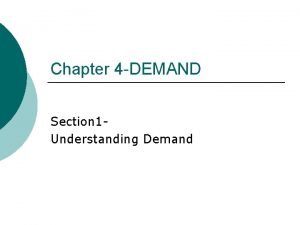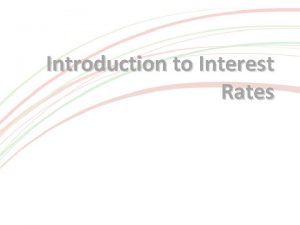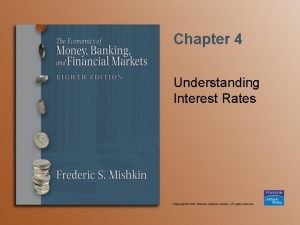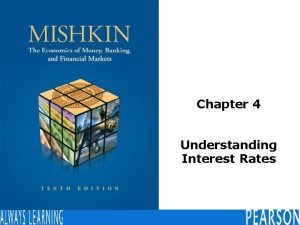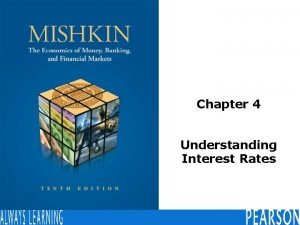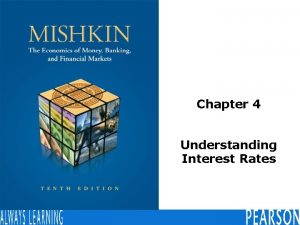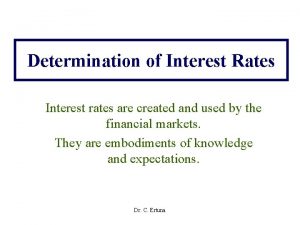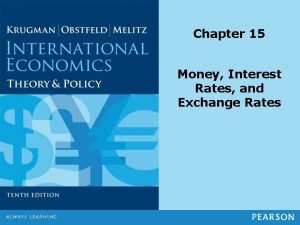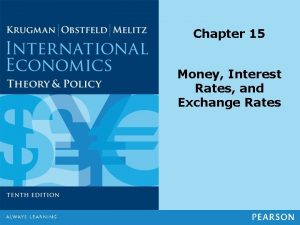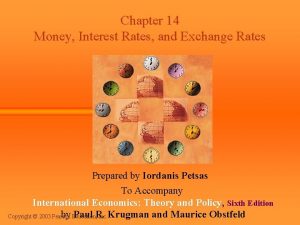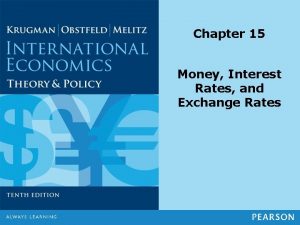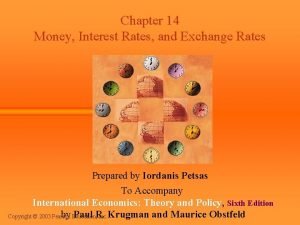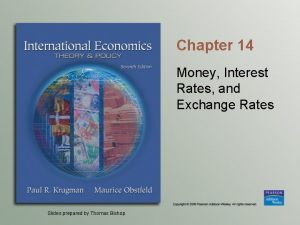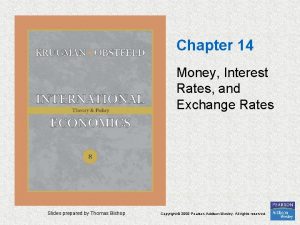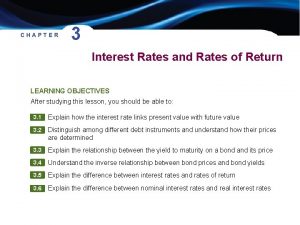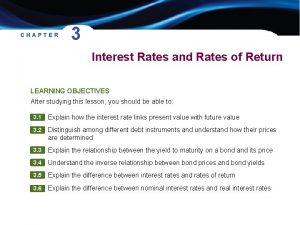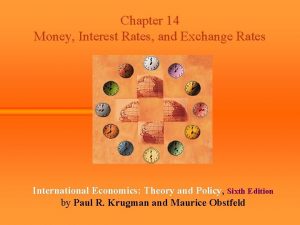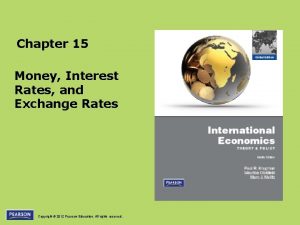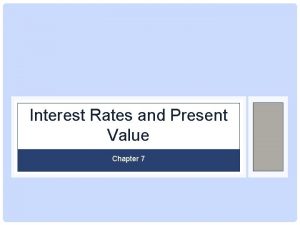Chapter 4 Understanding Interest Rates Interest Rates and




























































- Slides: 60

Chapter 4 Understanding Interest Rates

Interest Rates and the Economy Interest rates affect our daily lives and the health of the economy. They affect personal decisions – should I consume or save, buy a house, purchase bonds or stocks. They affect businesses – invest in new equipment or save money in a bank. Copyright © 2007 Pearson Addison-Wesley. All rights reserved. 4 -2

What does interest rate mean? Yield to Maturity is the most accurate measure of interest rates to economists. We will look at the difference between real interest rates, which are adjusted for inflation, and nominal interest rates, which are not. Interest rates play a key role in our lives. Copyright © 2007 Pearson Addison-Wesley. All rights reserved. 4 -3

Measuring Interest Rates • What is Present Value? • A dollar paid to you one year from now is less valuable than a dollar paid to you today. • Let’s look at the simplest kind of debt instrument, which we will call a simple loan. Copyright © 2007 Pearson Addison-Wesley. All rights reserved. 4 -4

Simple Loan • Lender provides the borrower with an amount of funds (called the principle), that must be repaid to the lender at the maturity date, along with the payment for the interest. • For example, I loan Jane $100 for 1 year. I require her to repay the principle of $100 and an additional payment of $10 for interest. • i = $10/$100 =. 010 = 10% Copyright © 2007 Pearson Addison-Wesley. All rights reserved. 4 -5

Discounting the Future Copyright © 2007 Pearson Addison-Wesley. All rights reserved. 4 -6

Discounting the Future • Copyright © 2007 Pearson Addison-Wesley. All rights reserved. 4 -7

Discounting the Future • This process of calculating today’s value of dollars received in the future, as we just did is called discounting the future. • We can simplify this process by writing today’s present value of $100 as PV, the future cash flow (payment) as CF and replacing 0. 10, the interest rate as: Copyright © 2007 Pearson Addison-Wesley. All rights reserved. 4 -8

Simple Present Value Copyright © 2007 Pearson Addison-Wesley. All rights reserved. 4 -9

Application: Simple Present Value What is the present value of $250 paid in 2 years with interest rate of 15%? Present value would be $189. 04 Using: Where: CF = cash flow in 2 years = $250 i = annual interest rate = 0. 15 n = number of years =2 Thus: Today $189. 04 Copyright © 2007 Pearson Addison-Wesley. All rights reserved. Year 1 Year 2 $250 4 -10

Application: How much is that Jackpot worth? Assume you just hit the $20 million jackpot in a lottery which promises to pay $1 million for the next 20 years. Have you really won $20 million? No, in present value it is worth a lot less. If we assume an interest rate of 10% the 1 st payment is worth $1 million today, but the next year the payment is only worth $909, 090: Now, after 20 years here is the result: = $9. 4 million Copyright © 2007 Pearson Addison-Wesley. All rights reserved. Show to use excel. 4 -11

4 Types of Credit Market Instruments 1. Simple Loan – Lender provides the borrower with an amount of funds, which must be repaid to lender at the maturity date along with a payment for interest. 2. Fixed Payment Loan 3. Coupon Bond 4. Discount Bond Copyright © 2007 Pearson Addison-Wesley. All rights reserved. 4 -12

1. Simple Loan Formula Copyright © 2007 Pearson Addison-Wesley. All rights reserved. 4 -13

Yield to Maturity • Of several ways to calculate interest rates the most common is the yield to maturity, the interest rate that equates the present value of cash flow payments received from a debt instrument with its value today. Because this makes good economic sense, economists consider it the most accurate measure of interests rates. Copyright © 2007 Pearson Addison-Wesley. All rights reserved. 4 -14

Simple Loan—Yield to Maturity Copyright © 2007 Pearson Addison-Wesley. All rights reserved. 4 -15

2. Fixed-payment loan Or called a fully amortized loan, where the lender provides borrower with an amount of funds, which must be repaid by making same payment every period (such as month), consisting of part principal and interest for a set number of years. For example, if you borrowed $1, 000 the loan might require you to pay $126 every year for 25 years. Installment loans, such as auto loans and mortgages are this type. Let’s look at this: Copyright © 2007 Pearson Addison-Wesley. All rights reserved. 4 -16

Fixed-payment loan • Copyright © 2007 Pearson Addison-Wesley. All rights reserved. 4 -17

Fixed Payment Loan— Yield to Maturity Copyright © 2007 Pearson Addison-Wesley. All rights reserved. 4 -18

APPLICATION – Yield to Maturity and the Yearly Payment on a Fixed-Payment Loan • Copyright © 2007 Pearson Addison-Wesley. All rights reserved. 4 -19

3. Coupon Bond Coupon bonds have more than one cash flow payment. The present value of the bond is calculated as the sum of the present values of all the coupon payments plus the present value of the final payment of the face value of the bond. Since calculating coupon bonds is not easy and requires business-oriented software we will not be calculating yield to maturity for coupon bonds. Copyright © 2007 Pearson Addison-Wesley. All rights reserved. 4 -20

3. Coupon Bond—Yield to Maturity Copyright © 2007 Pearson Addison-Wesley. All rights reserved. 4 -21

Coupon Bond - Application • On Excel: • =price(settlement (day 1), maturity (days over 8 years), rate, yield, redemption (security’s redemption value), frequency (payment once a year). • =price(1, 2923, . 10, , 1225, 100, 1) • =88. 91976821 or 89% of bond =889. 20 Copyright © 2007 Pearson Addison-Wesley. All rights reserved. 4 -22

• When the coupon bond is priced at its face value, the yield to maturity equals the coupon rate • The price of a coupon bond and the yield to maturity are negatively related • The yield to maturity is greater than the coupon rate when the bond price is below its face value Copyright © 2007 Pearson Addison-Wesley. All rights reserved. 4 -23

Study Questions 1. Would a dollar tomorrow be worth more to you today when the interest rate is 20% or 10%? 2. You have just won $10 million in the lottery, which promises to pay you $1 million every year for the next 10 years. Have you really won $10 million? 3. If the interest rate is 10%, what is the present value of a security that pays you $1, 100 next year, $1210 the year after, and $1331, the year after that? 4. If the security in problem 3 sold for $3, 500, is then yield to maturity greater or less than 10%? Why? Copyright © 2007 Pearson Addison-Wesley. All rights reserved. 4 -24

Question 1 Answer Would a dollar tomorrow be worth more to you today when the interest rate is 20% or 10%? PV = CF/(1 + i) Less. It would be worth 1/(1 + 0. 20) = $0. 83 when the interest rate is 20%, rather than 1/(1 + 0. 10) =$0. 91 when the interest rate is 10%. Copyright © 2007 Pearson Addison-Wesley. All rights reserved. 4 -25

Question 2 Answer You have just won $10 million in the lottery, which promises to pay you $1 million every year for the next 10 years. Have you really won $10 million? Assuming a 5% interest rate the present value would make payment only worth a little over $7 million. On excel: =PV(rate-. 05, # of payments-9, payment amount$1, 000, future value-0) = $7, 107, 821. 68 Copyright © 2007 Pearson Addison-Wesley. All rights reserved. 4 -26

Question 3 Answer If the interest rate is 10%, what is the present value of a security that pays you $1, 100 next year, $1210 the year after, and $1331, the year after that? $1, 100/(1 + 0. 10) + $1, 210/(1 + 0. 10)2 + $1, 331/(1 + 0. 10)3 = $3, 000 On excel: =NPV(rate-. 01, 1 st payment-1100, 2 nd payment 1210, 3 rd payment-1331) = $3, 000 Copyright © 2007 Pearson Addison-Wesley. All rights reserved. 4 -27

Question 4 Answer If the security in problem 3 sold for $3, 500, is then yield to maturity greater or less than 10%? Why? The yield to maturity is less than 10 percent. Only if the interest rate was less than 10 percent would the present value of the payments add up to $4, 000, which is more than the $3, 000 present value in the previous problem. =npv(. 02, 1100, 1210, 1331) = 3, 495. 68 Copyright © 2007 Pearson Addison-Wesley. All rights reserved. 4 -28

Study Questions 5. Write down the formula that is used to calculate the yield to maturity on a 20 year 10% coupon bond with $1, 000 face value that sells for $2, 000? 6. What is the yield to maturity on a simple loan for $1 million that requires a repayment of $2 million in 5 years’ time? 7. To pay for college, you have just taken out a $1, 000 government loan that makes you pay $126 per year for 25 years. However, you don’t have to start making payments for 2 years after college from now. Why is the yield to maturity necessarily less than 12%, the yield to maturity on a normal $1000 fixed payment loan which you pay $126 per year for 25 years? Copyright © 2007 Pearson Addison-Wesley. All rights reserved. 4 -29

Question 5 Answer Write down the formula that is used to calculate the yield to maturity on a 20 year 10% coupon bond with $1, 000 face value that sells for $2, 000? $2, 000 = $100/(1 + i) + $100/(1 + i)2 +. . . (Price-P) (Yearly coupon payment -C) + $100/(1 + i)20 + $1, 000/(1 + i)20 (Face value of bond-F) Copyright © 2007 Pearson Addison-Wesley. All rights reserved. 4 -30

Question 6 Answer: What is the yield to maturity on a simple loan for $1 million that requires a repayment of $2 million in 5 years’ time? • Copyright © 2007 Pearson Addison-Wesley. All rights reserved. 4 -31

Question 6 Answer continued • Copyright © 2007 Pearson Addison-Wesley. All rights reserved. 4 -32

Question 7 Answer To pay for college, you have just taken out a $1, 000 government loan that makes you pay $126 per year for 25 years. However, you don’t have to start making payments for 2 years after college from now. Why is the yield to maturity necessarily less than 12%, the yield to maturity on a normal $1000 fixed payment loan which you pay $126 per year for 25 years? If the interest rate were 12 percent, the present discounted value of the payments on the government loan are necessarily less than the $1, 000 loan amount because they do not start for two years. Thus the yield to maturity must be lower than 12 percent in order for the present discounted value of these payments to add up to $1, 000. Copyright © 2007 Pearson Addison-Wesley. All rights reserved. 4 -33

Question 7 Answer continued • On Excel: • =Rate (25, -126, 1000) = 12% # of payments, monthly payment, present value Having the extra years to pay lowers the interest payment below 12% Copyright © 2007 Pearson Addison-Wesley. All rights reserved. 4 -34

Discount Bond—Yield to Maturity Copyright © 2007 Pearson Addison-Wesley. All rights reserved. 4 -35

More Questions 8. What is the yield to maturity on a $1, 000 Face-value discount bond maturing in 1 year that sells for $800? 9. Which $1, 000 bond has the higher yield to maturity, a 20 year bond selling for $800 with a current yield of 15% or a 1 year bond selling for $800 with a current yield of 5%? Copyright © 2007 Pearson Addison-Wesley. All rights reserved. 4 -36

Question 8: What is the yield to maturity on a $1, 000 Face-value discount bond maturing in 1 year that sells for $800? • Copyright © 2007 Pearson Addison-Wesley. All rights reserved. 4 -37

Question 9 Answer Which $1, 000 bond has the higher yield to maturity, a 20 year bond selling for $800 with a current yield of 15% or a 1 year bond selling for $800 with a current yield of 5%? If the one-year bond did not have a coupon payment, its yield to maturity would be ($1, 000 − $800)/$800 − $200/$800 = 0. 25 = 25%. Because it does have a coupon payment, its yield to maturity must be greater than 25%. However, because the current yield is a good approximation of the yield to maturity for a twenty-year bond, we know that the yield to maturity on this bond is approximately 15%. Therefore, the one-year bond has a higher yield to maturity. Copyright © 2007 Pearson Addison-Wesley. All rights reserved. 4 -38

Yield on a Discount Basis Copyright © 2007 Pearson Addison-Wesley. All rights reserved. 4 -39

Following the Financial News: Bond Prices and Interest Rates

Differences between Interest Rates and Returns How well a person does by holding a bond or any other security over a certain time period is accurately measured by the return, or the rate of return. For any security, the rate of return is defined as the payments to the owner plus the change in its value, expressed as a fraction of the purchase price. Copyright © 2007 Pearson Addison-Wesley. All rights reserved. 4 -41

Example from the Book • Copyright © 2007 Pearson Addison-Wesley. All rights reserved. 4 -42

• When the coupon bond is priced at its face value, the yield to maturity equals the coupon rate • The price of a coupon bond and the yield to maturity are negatively related • The yield to maturity is greater than the coupon rate when the bond price is below its face value Copyright © 2007 Pearson Addison-Wesley. All rights reserved. 4 -43

Rate of Return Copyright © 2007 Pearson Addison-Wesley. All rights reserved. 4 -44

Rate of Return and Interest Rates • The return equals the yield to maturity only if the holding period equals the time to maturity • A rise in interest rates is associated with a fall in bond prices, resulting in a capital loss if time to maturity is longer than the holding period • The more distant a bond’s maturity, the greater the size of the percentage price change associated with an interest-rate change Copyright © 2007 Pearson Addison-Wesley. All rights reserved. 4 -45

Rate of Return and Interest Rates (cont’d) • The more distant a bond’s maturity, the lower the rate of return that occurs as a result of an increase in the interest rate • Even if a bond has a substantial initial interest rate, its return can be negative if interest rates rise Copyright © 2007 Pearson Addison-Wesley. All rights reserved. 4 -46

Copyright © 2007 Pearson Addison-Wesley. All rights reserved. 4 -47

Question 11 and 12 11. You are offered 2 bonds, a 1 -year US Treasury bond with a yield to maturity of 9% and a 1 -year US Treasury bill with a yield on a discount basis of 8. 9%. Which would you rather own? 12. If there is a decline in interest rates, which would you rather be holding, longterm bonds or short-term bonds? Why? Which type of bond has the greater interest rate risk? Copyright © 2007 Pearson Addison-Wesley. All rights reserved. 4 -48

Question 11 Answer You are offered 2 bonds, a 1 -year US Treasury bond with a yield to maturity of 9% and a 1 -year US Treasury bill with a yield on a discount basis of 8. 9%. Which would you rather own? You would rather own the Treasury bill, because it has a higher yield to maturity. As the example in the book indicates, the discount yield’s understatement of the yield to maturity for a one-year bill is substantial, exceeding one percentage point. Thus the yield to maturity on the one-year bill would be greater than 9%, the yield to maturity on the one-year Treasury bond. Copyright © 2007 Pearson Addison-Wesley. All rights reserved. 4 -49

Questions 12 Answer If there is a decline in interest rates, which would you rather be holding, long-term bonds or short-term bonds? Why? Which type of bond has the greater interest rate risk? You would rather be holding long-term bonds because their price would increase more than the price of the short-term bonds, giving them a higher return. Copyright © 2007 Pearson Addison-Wesley. All rights reserved. 4 -50

Questions 13 and 14 13. Francine the Financial Advisor has just given you the following advice: “Long term bonds are a great investment because their interest rate is over 20%. Is Francine right? 14. If mortgage rates rise from 5% to 10% but the expected rate of increase in housing prices rises from 2% to 9%, are people more or less likely to buy houses? Copyright © 2007 Pearson Addison-Wesley. All rights reserved. 4 -51

Questions 13 Answer Francine the Financial Advisor has just given you the following advice: “Long term bonds are a great investment because their interest rate is over 20%. Is Francine right? No. If interest rates rise sharply in the future, long-term bonds may suffer such a sharp fall in price that their return might be quite low—possibly even negative. Copyright © 2007 Pearson Addison-Wesley. All rights reserved. 4 -52

Question 14 Answer If mortgage rates rise from 5% to 10% but the expected rate of increase in housing prices rises from 2% to 9%, are people more or less likely to buy houses? People are more likely to buy houses because the real interest rate when purchasing a house has fallen from 3 percent (= 5 percent − 2 percent) to 1 percent (= 10 percent − 9 percent). The real cost of financing the house is thus lower, even though mortgage rates have risen. (If the tax deductibility of interest payments is allowed for, then it becomes even more likely that people will buy houses. ) Copyright © 2007 Pearson Addison-Wesley. All rights reserved. 4 -53

Interest-Rate Risk • Prices and returns for long-term bonds are more volatile than those for shorter-term bonds • There is no interest-rate risk for any bond whose time to maturity matches the holding period Copyright © 2007 Pearson Addison-Wesley. All rights reserved. 4 -54

Real and Nominal Interest Rates • Nominal interest rate makes no allowance for inflation • Real interest rate is adjusted for changes in price level so it more accurately reflects the cost of borrowing • Ex ante real interest rate is adjusted for expected changes in the price level • Ex post real interest rate is adjusted for actual changes in the price level Copyright © 2007 Pearson Addison-Wesley. All rights reserved. 4 -55

Fisher Equation Copyright © 2007 Pearson Addison-Wesley. All rights reserved. 4 -56

Copyright © 2007 Pearson Addison-Wesley. All rights reserved. 4 -57

CHAPTER 4 SUMMARY 1. The yield to maturity (the measure that most reflects the interest rate) is the interest rate that equates the present value of future payments of a debt instrument with its value today. 2. Application of this principle reveals that bond prices and interest rates are negatively related: when interest rate rises, the price of the bond must fall, and vice versa. Copyright © 2007 Pearson Addison-Wesley. All rights reserved. 4 -58

CHAPTER 4 SUMMARY continued 3. Two less accurate measures of interest rates are coupon bonds and discount bonds. 4. The return on a security (tells you how well you have done by holding the security over a stated period of time) can differ quite a bit from the interest rate as measured by the yield to maturity. For example, long-term bond prices have huge fluctuations (ups and downs) when interest rates change and thus bear interest-rate risk. The gains and losses can be large which is why long-term bonds are not considered to be safe assets with a sure return. Copyright © 2007 Pearson Addison-Wesley. All rights reserved. 4 -59

CHAPTER 4 SUMMARY continued 5. The real interest rate is defined as the nominal interest rate minus the expected rate of inflation. It is a better measure of the incentives to borrow and lend than the nominal interest rate, and it is a more accurate indicator of the tightness of credit market conditions than the nominal interest rate. Copyright © 2007 Pearson Addison-Wesley. All rights reserved. 4 -60
 Chapter 7 interest rates and bond valuation
Chapter 7 interest rates and bond valuation How to find the price of a bond
How to find the price of a bond Chapter 6 interest rates and bond valuation
Chapter 6 interest rates and bond valuation Chapter 7 interest rates and bond valuation
Chapter 7 interest rates and bond valuation Chapter 6 interest rates and bond valuation
Chapter 6 interest rates and bond valuation Is a ratio a rate
Is a ratio a rate Equivalent ratios
Equivalent ratios Ratios rates and unit rates
Ratios rates and unit rates Ratios rates and unit rates
Ratios rates and unit rates Interest rates and economic growth
Interest rates and economic growth Increase money supply
Increase money supply Interest rates and price level
Interest rates and price level Unit 5 macroeconomics lesson 2 activity 45
Unit 5 macroeconomics lesson 2 activity 45 Disadvantages of high interest rates
Disadvantages of high interest rates Interest rate quotes
Interest rate quotes Effective interest rate formula
Effective interest rate formula Determinants of interest rates
Determinants of interest rates Unit 2 lesson 12 interest rates
Unit 2 lesson 12 interest rates Nominal v. real interest rates
Nominal v. real interest rates Interest rates
Interest rates Interest rate curve construction
Interest rate curve construction Interest rates
Interest rates Interest rates
Interest rates The interest
The interest Compound interest multiplier
Compound interest multiplier Reaction rates and equilibrium worksheet answers chapter 19
Reaction rates and equilibrium worksheet answers chapter 19 Chapter 18 reaction rates and equilibrium answer key
Chapter 18 reaction rates and equilibrium answer key Chapter 18 reaction rates and equilibrium
Chapter 18 reaction rates and equilibrium Chapter 8 risk and rates of return problem solutions
Chapter 8 risk and rates of return problem solutions Chapter 23 understanding income and taxes
Chapter 23 understanding income and taxes Understanding your health and wellness chapter 1
Understanding your health and wellness chapter 1 Goodheart willcox chapter 1 answers
Goodheart willcox chapter 1 answers Chapter 1 understanding your health and wellness
Chapter 1 understanding your health and wellness Chapter 1 understanding health and wellness lesson 4
Chapter 1 understanding health and wellness lesson 4 Chapter 1 lesson 2 what affects your health
Chapter 1 lesson 2 what affects your health Chapter 1 understanding health and wellness lesson 2
Chapter 1 understanding health and wellness lesson 2 Chapter 1 lesson 1 your total health
Chapter 1 lesson 1 your total health Chapter 1 understanding your health and wellness
Chapter 1 understanding your health and wellness Chapter 5 understanding and comparing distributions answers
Chapter 5 understanding and comparing distributions answers Chapter 1 understanding health and wellness lesson 3
Chapter 1 understanding health and wellness lesson 3 Chapter 9 lesson 3 understanding violence
Chapter 9 lesson 3 understanding violence Understanding the scriptures chapter 24 study questions
Understanding the scriptures chapter 24 study questions Chapter 6 understanding the management process
Chapter 6 understanding the management process Understanding the management process
Understanding the management process Chapter 5 section 1 understanding supply
Chapter 5 section 1 understanding supply Sarophytes
Sarophytes Understanding the scriptures chapter 22 study questions
Understanding the scriptures chapter 22 study questions Understanding the scriptures chapter 20 study questions
Understanding the scriptures chapter 20 study questions Chapter 16 section 3 severe weather answer key
Chapter 16 section 3 severe weather answer key Chapter 8 understanding populations
Chapter 8 understanding populations Chapter 4 lesson 1 understanding stress
Chapter 4 lesson 1 understanding stress Lesson 1 understanding demand
Lesson 1 understanding demand Ap stats chapter 10 understanding randomness
Ap stats chapter 10 understanding randomness Understanding human communication 14th edition chapter 1
Understanding human communication 14th edition chapter 1 Chapter 1 understanding business communication
Chapter 1 understanding business communication Business essentials 12th edition
Business essentials 12th edition Chapter 1 section 1 understanding our environment answers
Chapter 1 section 1 understanding our environment answers Understanding foodservice operations chapter 2
Understanding foodservice operations chapter 2 Understanding the scriptures chapter 6 study questions
Understanding the scriptures chapter 6 study questions Understanding the scriptures chapter 5 study questions
Understanding the scriptures chapter 5 study questions Economics chapter 4 section 1 understanding demand answers
Economics chapter 4 section 1 understanding demand answers


